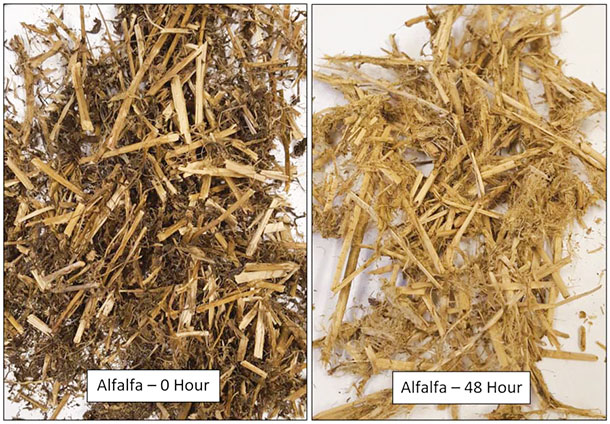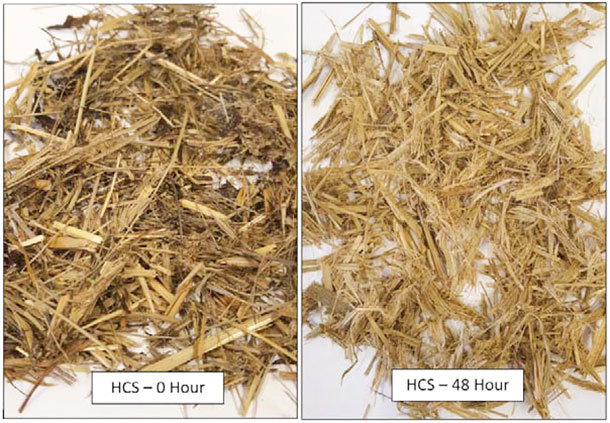With the help of John Kjolhaug, I was able to get my hands on a pure alfalfa silage sample from the Midwest. Using both the alfalfa sample as well as a hay crop silage (HCS) sample from the Miner farm, I conducted a small in situ project to illustrate how the two samples breakdown differently in the rumen.
The samples were placed inside in situ bags and then in the rumen of a cannulated cow for 48 hours. When the samples were removed, they were paired with their corresponding zero-hour (no ruminal fermentation) sample and washed and rinsed. The samples were dried and then removed from the in situ bags. The results can be seen in the corresponding photos.


It is important to point out that the change between the zero- and 48-hour samples is strictly due to the rumen microbes and that the dairy cow was unable to masticate the sample. The first thing that you may notice is that the forages lose their green color. When taking a closer look, it can be observed that portions of each sample have begun to fray apart. It is primarily the leaves in the alfalfa sample that have separated into stringy portions, while the stems appear to retain their original shape. On the other hand, both the leaves and stems of the HCS sample exhibit this fraying action.
The difference between the alfalfa and HCS 48-hour samples is subtle but important. This is critical because it illustrates a portion of why legumes and grasses have different passage rates. The differences between legumes and grasses have been previously examined, and one study that explains this well is Kammes and Allen, 2012. They utilized alfalfa silage and orchardgrass silage to compare passage rates as well as the rumen dynamics. They found that the diet containing orchardgrass silage had a slower passage rate for smaller fiber particles. They found that over 55 percent of the particles within the rumen were less than 2.36 millimeters for both silages, meaning that particle size was most likely not the limiting factor of passage. Kammes and Allen attribute the difference in passage to the selective retention of particles in the rumen. This can also be described as the entanglement of particles in the rumen mat.
Now, with this in mind, refer back to the pictures of the 48-hour in situ samples. The HCS sample appears to contain a greater amount of particles frayed apart. Not to say that the alfalfa sample lacks this, but it is not to the same degree.
The difference between legume and grass is largely due to their structural makeup. The difference between the two is often described as building blocks for legumes and cords running together, similar to a rope, for grasses. The in situ samples help illustrate this difference, and I believe this is an important concept to keep in mind when feeding different forages to ruminants. Grass particles will fray apart to a greater degree than legume particles, increasing the probability of entanglement in the rumen mat and in turn slowing passage. We need to recognize that although they can be similar, legumes and grasses are still very different. ![]()
This article originally appeared in the The William H. Miner Agricultural Research Institute Farm Report.
References omitted but are available upon request. Click here to email an editor.











